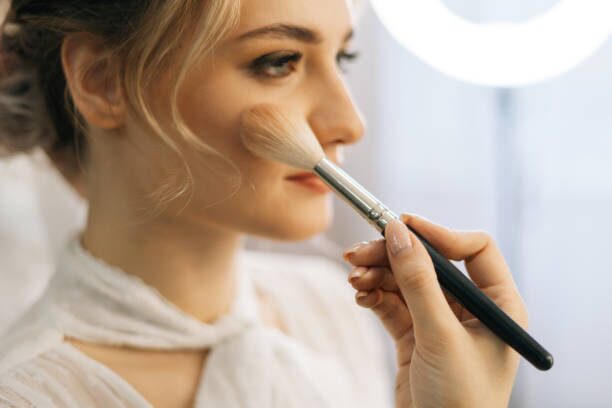Contents

Planning a wedding is a complex process where every detail matters. One of the key elements of your bridal look is hair and makeup. Choosing the right wedding stylist is essential, but even the most skilled professional cannot fully bring your vision to life if you don’t clearly communicate your desires. So, how can you effectively explain to your stylist exactly what you want? Let’s break it down step by step.
Define Your Preferences
Before meeting with your stylist, take some time to explore and shape your ideas. Use the following methods:
- Find inspiration. Browse Pinterest, Instagram, wedding blogs, and magazines. Save photos of makeup and hairstyles you like. Aim for looks that match your skin tone, face shape, and wedding theme.
- Consider your personal style. Think about what style suits you best: classic, romantic, boho, minimalist, or glamorous. Your wedding look should align with your dress and the overall theme of your big day.
- Understand your features. Focus on the facial features you want to highlight and any unique characteristics of your hair. For instance, if you have short hair, not all hairstyles from catalogs may be feasible.
Prepare for the Consultation
Before your first meeting with the stylist, gather everything that can help them understand your vision and personal style:
- Photos of your dress. Knowing the style, color, and details of your dress will help the stylist craft a cohesive look.
- Wedding day schedule. If your day is packed with activities, the stylist can ensure that your hair and makeup are long-lasting.
- Daily makeup photos. Bring pictures of how you typically do your makeup in everyday life. This helps the stylist understand your preferences and comfort zone. For example, you might point out, “This is my everyday look,” or “This feels like too much makeup for me.” This is particularly helpful since many brides arrive for their trial session without any makeup on, which might make it harder for the stylist to gauge your usual style.
- Examples of desired looks. Share collected photos of makeup and hairstyles that resonate with you. These visual aids will clarify your preferences and guide the stylist in designing a personalized look.
Communicate Your Expectations Clearly
When discussing your bridal look, communication is crucial. Be as specific as possible:
- Describe details. Instead of vague terms like “soft makeup,” explain, “I like subtle eye makeup with a nude lip.”
- Share your habits and preferences. If bold or heavy makeup feels uncomfortable, mention this. For example, “I usually prefer a natural look, so I’d like to keep it light.”
- Provide feedback during the trial. The trial session is the time to speak up. If something feels off, say so—whether it’s “The curls feel too tight,” or “The lipstick color feels too bold for me.” Trials are specifically meant for adjustments, and the more feedback you give, the closer the stylist can get to achieving your ideal look.
Remember, silence during the trial can lead to dissatisfaction on the wedding day. Open, constructive communication ensures the final result aligns with your vision.
Schedule a Trial Session
A trial run for your hair and makeup is essential to test your bridal look ahead of time. This will help avoid surprises on your wedding day.
- Provide feedback. If something doesn’t feel right, don’t hesitate to speak up. For example, “I think the curls are too tight,” or “I’d like more shimmer on my eyes.”
- Take photos. Capture the look under different lighting conditions to see how it photographs, as your wedding pictures will last a lifetime.
Consider External Factors
The wedding day is full of nuances that can influence your look. Make sure your stylist takes these into account:
- Weather. If the ceremony is outdoors on a hot day, makeup should be long-lasting, and the hairstyle should be well-secured.
- Activity level. If you plan to dance and move around a lot, your hair and makeup need to withstand the activity.
- Time of day. Makeup for a daytime wedding can be more natural, while an evening ceremony may call for a more dramatic look.
Keep the Dialogue Open
Building a good rapport with your stylist is key to success. Don’t hesitate to ask questions and clarify details:
- “How long will this hairstyle last?”
- “What products do you use?”
- “Can adjustments be made on the wedding day if needed?”
Trust the Professional
Hiring a wedding stylist means you’re placing trust in their expertise and skills. Sometimes your ideas may not align perfectly with reality, but a good stylist will offer the best solution to make you look stunning.
Don’t Skip the Makeup and Hair Trial
Many brides underestimate the importance of a trial session, but it’s an invaluable way to avoid stress on the wedding day. Even if everything seems clear, a rehearsal ensures that the stylist fully understands your expectations.
Conclusion
Clear communication with your stylist is the key to achieving your perfect bridal look. Come prepared with visual references, be specific in your descriptions, and trust the professional. Your role is not only to share your wishes but also to be open to the stylist’s advice. On this important day, you deserve to feel confident and flawless!